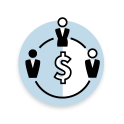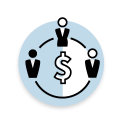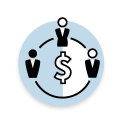
Evaluation of Scaling the New Orleans Charter Restart Model:
Evaluation Findings
CREDO's federally mandated independent evaluation of the Charter Restart Model (CRM) used a mixed methods design to test the CRM's Theory of Action and its impact on students in Louisiana and Tennessee from 2010-2016. We organized the evaluation around 3 strands of work:
- The Organizational Capacity study examined the administrative and policy activities at the systems level required to support, scale, and sustain the CRM
- The Implementation study investigated the experience of school-level stakeholders in the day-to-day work of turning around a failing school.
- The Student Impact study determined the extent to which implementation of the CRM resulted in improved student performance.
 Here are the questions we asked.
Here are the questions we asked.
-
 1. Did selection surface strong operators in alignment with the promises of the Theory of Action?The CRM Theory of Action posits that partnership with current and aspiring charter management organizations (CMOs) with proven track records results in higher quality school turnarounds. Did NSNO invest in charter school entities that were strong?
1. Did selection surface strong operators in alignment with the promises of the Theory of Action?The CRM Theory of Action posits that partnership with current and aspiring charter management organizations (CMOs) with proven track records results in higher quality school turnarounds. Did NSNO invest in charter school entities that were strong? -
 2. How do CMOs operate as agents of change, innovation, and quality?The CRM identifies CMOs specifically as levers for systems change. How did the i3-funded CMOs effect change, innovate in their schools and in the larger ecosystem, and achieve quality for their students?
2. How do CMOs operate as agents of change, innovation, and quality?The CRM identifies CMOs specifically as levers for systems change. How did the i3-funded CMOs effect change, innovate in their schools and in the larger ecosystem, and achieve quality for their students? -
 3. Did Scaling the Charter Restart Model occur as proposed?The CRM as originally conceived aimed to create a large scale change-management system. Was the CRM initiative implemented with fidelity to the Theory of Action as it was originally designed?
3. Did Scaling the Charter Restart Model occur as proposed?The CRM as originally conceived aimed to create a large scale change-management system. Was the CRM initiative implemented with fidelity to the Theory of Action as it was originally designed? -
 4. Was the CRM implemented with fidelity at the school level?The CRM identified potential school turnaround partners based on positive results in the schools those operators were already running. Did the CRM schools faithfully implement the models their operators had previously developed?
4. Was the CRM implemented with fidelity at the school level?The CRM identified potential school turnaround partners based on positive results in the schools those operators were already running. Did the CRM schools faithfully implement the models their operators had previously developed? -
 5. As the CRM matured over time, what lessons were learned regarding school management, network management, and systems management?Successful turnaround requires optimal functioning in multiple domains. How did the CRM schools evolve systems, practices, and resources to successfully turn around low performing schools?
5. As the CRM matured over time, what lessons were learned regarding school management, network management, and systems management?Successful turnaround requires optimal functioning in multiple domains. How did the CRM schools evolve systems, practices, and resources to successfully turn around low performing schools? -
 6. Are the CRM schools performance management-focused organizations?Using CREDO’s Performance Management Organization (PMO) rubric, the evaluation tested CRM schools’ alignment with known best practice. How do CRM schools score on the PMO?
6. Are the CRM schools performance management-focused organizations?Using CREDO’s Performance Management Organization (PMO) rubric, the evaluation tested CRM schools’ alignment with known best practice. How do CRM schools score on the PMO? -
 7. What can we learn from the CRM schools that ultimately did not succeed?Six CRM schools in this evaluation eventually failed: they lost their charters, exited the CRM cohort, or closed their doors entirely. What can we learn from this subset of schools?
7. What can we learn from the CRM schools that ultimately did not succeed?Six CRM schools in this evaluation eventually failed: they lost their charters, exited the CRM cohort, or closed their doors entirely. What can we learn from this subset of schools? -
 8. Did the Charter Restart Model’s installation result in positive impact for student learning?The CRM’s ultimate goal was to increase school quality. Did academic performance improve for students attending CRM schools?
8. Did the Charter Restart Model’s installation result in positive impact for student learning?The CRM’s ultimate goal was to increase school quality. Did academic performance improve for students attending CRM schools? -
 9. How did the CRM give rise to systems-level coordination functions in order to support 50,000 high quality seats?The CRM was designed to be a lever for universal high quality in all public schools. Did NSNO’s CRM investments result in universal high quality for every public school student in New Orleans?
9. How did the CRM give rise to systems-level coordination functions in order to support 50,000 high quality seats?The CRM was designed to be a lever for universal high quality in all public schools. Did NSNO’s CRM investments result in universal high quality for every public school student in New Orleans? -
 10. Did the Scaling the New Orleans Charter Restart Model succeed?Did NSNO meet its goals for number of schools turned around, number of students served, and establishment of permanent infrastructure to scale and maintain the CRM?
10. Did the Scaling the New Orleans Charter Restart Model succeed?Did NSNO meet its goals for number of schools turned around, number of students served, and establishment of permanent infrastructure to scale and maintain the CRM? -
 11. What are the implications of Scaling the New Orleans Charter Restart Model going forward?What implications for policy and practice arise from the findings regarding the CRM?
11. What are the implications of Scaling the New Orleans Charter Restart Model going forward?What implications for policy and practice arise from the findings regarding the CRM?
Investigate
the Organizational Capacity Report
to explore the policy analysis and systems-level findings of the evaluation.
Go to
The List of Schools
to learn more about each CRM school in
the evaluation.
Investigate
The Student Impact Report
for a full analysis of the CRM’s results on student learning.